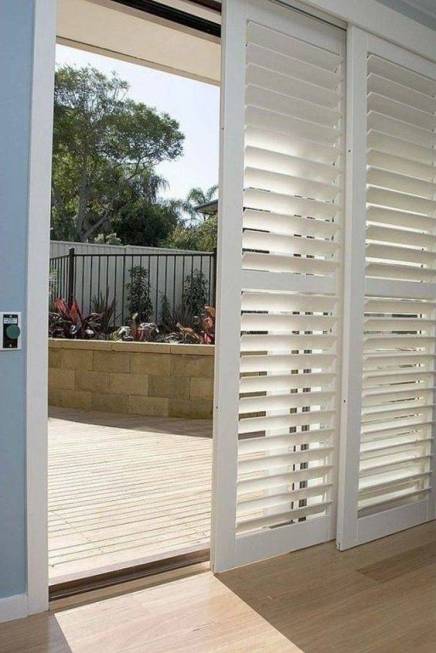Options available for covering sliding glass doors

Dear Gail: We just bought our first home and are very excited. We decided on wood floors and wood blinds for the windows. We have a sliding glass door in our family room and are not sure what we should do on it. We had vertical blinds in our apartment and really didn’t care for them. Can we put the wood blinds on the sliding door also? — Rhonda
Dear Rhonda: Congratulations on your first new home, how exciting for you. I know that many people have trouble dressing their sliding glass door and want something other than PVC vertical blinds, but please do not place wood blinds on the door.
Wood blinds are a horizontal window treatment, the same as mini blinds. When I say horizontal treatments, it’s that the slats go across your window from side to side, and when you pull them open, they go up and down. A vertical treatment has slats that go from top to bottom and when pulled open go side to side.
Horizontal treatments, especially mini and wood blinds are not really meant to be pulled up and down on the window. Especially on a sliding door, the weight of the blinds and continued pulling up and down will wear your headrail and cords quickly, and there is a chance you will pull the blind right out of the window header.
Fabric treatments are lighter in weight and are easier to operate but still have weight to them because of the size of the window. With a horizontal treatment, consider the hassle of having to raise the treatment completely off the window every time you want to open the door.
So what are your options? Sliding wood shutter panels are the most popular. On the operating side of your slider, the shutter panel will slide off of it and in front of the other panel to let you get out of your door. The louvers have to be closed before sliding the panels back, so you will lose the view out of one side of your door.
Just like wood blinds, the louvers can be tilted for light and privacy adjustment. I always suggest getting a larger louver so you will have a clearer view out the window when they’re open.
If you have a great view to your yard and want it unobstructed, consider a bi-fold shutter. A bi-fold shutter allows the shutters to slide and fold open. The individual panels are hinged together and operate on a top track, like an accordion closet door.
Another favorite vertical option is sliding panels, also known as panel track blinds. They have more of a contemporary feel, but you can change that depending upon the material selection.
Instead of narrow PVC slats as you have on a traditional vertical blind, sliding panels are made from wider flat fabric panels. They hang from top to bottom like a vertical blind, and when opened, the panels slide behind each other and lay flat against the wall.
Then you have traverse drapery panels. Now I know you’re thinking about the type your grandmother had on the ugly white traverse rod, but things have come a long way. In case you’re not familiar with a traverse rod, it’s simply a drapery rod that you open and close by pulling a cord, sort of like a pulley. They make beautiful traverse rods in iron and wood.
Your panels can be attached on rings which are directly attached to the rod and allow the rings to slide across the full length of the door. So no pulling the panels back and forth by hand.
You can use a traditional decorative rod with ring clips or grommets, but be aware that the center support brackets will prevent you from sliding the panels all the way across the door. So you will need to have two panels instead.
If you select this option, my suggestion is to invest in a decorative traverse rod. Of course, you can always use a standard traverse rod and then add a decorative valance to cover it.
One note of caution with a drapery panel treatment is to remember that the fabric is going to pull over to the permanent window side of your door and stack there when you have the door open. Fabric treatments have more fullness then others, and if you don’t have much wall space next to the door, most of the panel is going to be in front of your window.
When having it made, ask about the “stack back” of the treatment. That is how much wall space the panel will take up when it’s pulled open.
Rhonda, I hope one of these options work for you. Enjoy your new home.
Gail Mayhugh, owner of GMJ Interiors, is a professional interior designer and author of a book on the subject. Questions may be sent by email to GMJinteriors@gmail.com. Or, mail to 7380 S. Eastern Ave., No. 124-272, Las Vegas, NV 89123. Her web address is www.GMJinteriors.com.